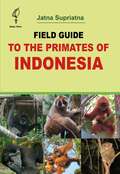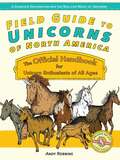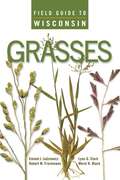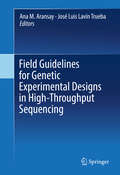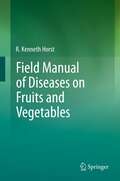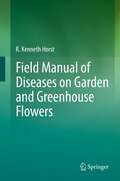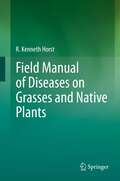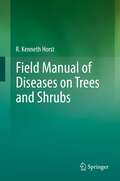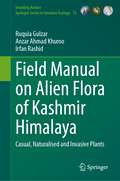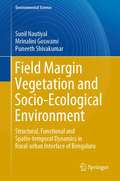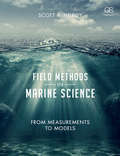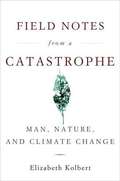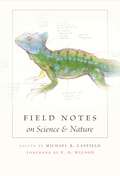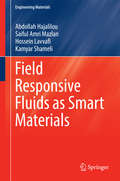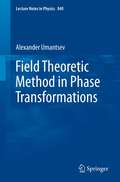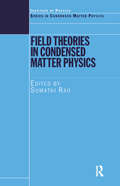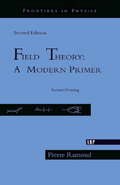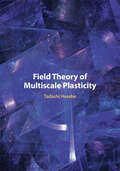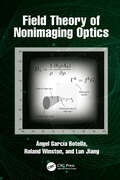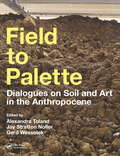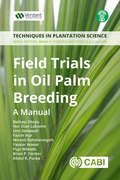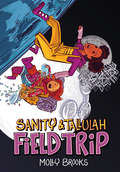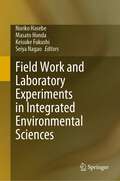- Table View
- List View
Field Guide to the Primates of Indonesia
by Jatna SupriatnaThis primate field guide can be used to refer to information on each species, or it can be used to find which species exist on each island, as shown at the back of the book. A list of primates in Indonesia is provided with local, English, and scientific names. Once the name is identified the user can go to the description of the genus and species. Also given is the conservation status of each species except for the most recently described, whose status is not yet known. The information on each species' natural history, behavior, ecology, and where to see it in parks and/or forested areas outside parks is included. Field Guide to the Primates of Indonesia primate drawings are by Stephen Nash and photographs were donated by many of the author's friends from Indonesia and abroad.
Field Guide to Unicorns of North America: The Official Handbook for Unicorn Enthusiasts of All Ages
by Andy RobbinsBecome an expert on the various species of North American Unicornus thanks to this fun, funny, and fascinating field guide!From historical details to identification strategies, you&’ll soon be immersed in the world of unicorns that roam the wilds of North America thanks to the scientific, "fact-packed" handbook. Plus, you&’ll learn easy, step-by-step drawing techniques for when you&’re out in the wild searching for signs of unicorn presence. Along with unicorn history, popular tales, and scientific information, you&’ll be provided with in-depth details about the most popular species of North American unicorns, including: • American Unicorn • Hoary Unicorn • Spiked Bog Pony • Tropical Unicorn • And more! This field guide is perfect for any lover of these fantastic beasts, no matter if they believe unicorns to be fact or fiction!
Field Guide to Wisconsin Grasses
by Emmet J. Judziewicz Robert W. Freckmann Lynn G. Clark Merel R. BlackGrasses are the foremost plant family of prairies, savannas, barrens, many agricultural landscapes, lawns, and successional habitats throughout Wisconsin, yet they are notoriously difficult to identify. This field guide to 232 species of Wisconsin grasses includes more than 1,100 illustrations. Setting a new standard as the first new, illustrated midwestern grass identification manual to appear since the 1960s, it provides up-to-date, comprehensive information for naturalists, gardeners, landscapers, nursery horticulturalists, community restoration professionals, agronomists and biologists, and any outdoors lover. The book includes: #149; species descriptions and distribution maps for all 232 species #149; more than 700 color photographs accompanying species descriptions #149; drawings of most species #149; chapters on grass morphology and grasses in natural communities #149; keys to all species, including an illustrated key to genera #149; a glossary of grass terminology.
Field Guidelines for Genetic Experimental Designs in High-Throughput Sequencing
by Ana M. Aransay José Luis Lavín TruebaHigh throughput sequencing (HTS) technologies have conquered the genomics and epigenomics worlds. The applications of HTS methods are wide, and can be used to sequence everything from whole or partial genomes, transcriptomes, non-coding RNAs, ribosome profiling, to single-cell sequencing. Having such diversity of alternatives, there is a demand for information by research scientists without experience in HTS that need to choose the most suitable methodology or combination of platforms and to define their experimental designs to achieve their specific objectives. Field Guidelines for Genetic Experimental Designs in High-Throughput Sequencing aims to collect in a single volume all aspects that should be taken into account when HTS technologies are being incorporated into a research project and the reasons behind them. Moreover, examples of several successful strategies will be analyzed to make the point of the crucial features. This book will be of use to all scientist that are unfamiliar with HTS and want to incorporate such technologies to their research.
Field Manual of Diseases on Fruits and Vegetables
by R. Kenneth HorstThe Fruits and Vegetables manual is a reference manual on diseases which attack fruits (including berries), vegetables, and nuts. The manual identifies various types of diseases which are known to invade these plants located throughout North, Central, and South America. The recordings include diseases caused by fungi, bacteria, viruses, viroids, phytoplasmas, and nematodes. Causal disease agents are described and illustrated in some cases and diseases and disease control measures are also discussed. A manual such as this is never finished since new reports of diseases are continuously reported.
Field Manual of Diseases on Garden and Greenhouse Flowers
by R. Kenneth HorstThe Garden and Greenhouse Flowers manual is a reference manual on diseases which attack garden and greenhouse flowers. The manual identifies various types of diseases which are known to invade these plants located throughout North, Central, and South America.The recordings include diseases caused by fungi, bacteria, viruses, viroids, phytoplasmas, and nematodes. Causal disease agents are described and illustrated in some cases and diseases and disease control measures are also discussed. A manual such as this is never finished since new reports of diseases are continuously reported.
Field Manual of Diseases on Grasses and Native Plants
by R. Kenneth HorstThe Grasses and Native Plants manual is a reference manual on diseases which attack grasses, forage, native flowers, and weeds. The manual identifies various types of diseases which are known to invade these plants located throughout North, Central, and South America. The recordings include diseases caused by fungi, bacteria, viruses, viroids, phytoplasmas, and nematodes. Causal disease agents are described and illustrated in some cases and diseases and disease control measures are also discussed. A manual such as this is never finished since new reports of diseases are continuously reported.
Field Manual of Diseases on Trees and Shrubs
by R. Kenneth HorstThe Trees and Shrubs manual is a reference manual on diseases which attack trees, shrubs, and vines. The manual identifies various types of diseases which are known to invade these plants located throughout North, Central, and South America. The recordings include diseases caused by fungi, bacteria, viruses, viroids, phytoplasmas, and nematodes. Causal disease agents are described and illustrated in some cases and diseases and disease control measures are also discussed. A manual such as this is never finished since new reports of diseases are continuously reported.
Field Manual on Alien Flora of Kashmir Himalaya: Casual, Naturalised and Invasive Plants (Invading Nature - Springer Series in Invasion Ecology #15)
by Ruquia Gulzar Anzar Ahmad Khuroo Irfan RashidThe book “Field Manual on Alien Flora of Kashmir Himalaya: Casual, Naturalised and Invasive Plants” has been prepared with two main goals in mind: (i) to promote awareness on the threats of invasive alien plants to biodiversity, ecology and environment, and (ii) to encourage research on, and management of, the alien plants. The Manual contains concise information on the taxonomy, ecology, invasion status, impacts, distribution and illustrated photo-plates of the alien plant species of Kashmir Himalaya, India. The Manual has three chapters: Chapter-I provides a general introduction to the discipline of invasion ecology. Chapter-II guides the readers on how to use the Manual, including brief information on the study region, methods, definitions and terminology used. Chapter-III comprises the bulk of this Manual, providing profile of 100 alien plant species with scientific information on the botanical, english and local names, taxonomic characters, ecological traits, current invasion status (casual, naturalised and invasive), impacts, native range, species’ distribution-map in Kashmir Himalaya and coloured illustrations that will aid in field identification. It is hoped that the Manual will increase awareness on the threats posed by plant invasions among all the stakeholders - researchers, land managers, policy makers, environmentalists, naturalists, citizen-scientists, students, and the general public. It will also help in promoting research, formulating policies and planning management actions to deal with invasive alien species.
Field Margin Vegetation and Socio-Ecological Environment: Structural, Functional and Spatio-temporal Dynamics in Rural-urban Interface of Bengaluru (Environmental Science and Engineering)
by Sunil Nautiyal Mrinalini Goswami Puneeth ShivakumarThis book has been produced as a part of the project ‘Social-Ecological Systems at the Indian Rural-Urban Interface: Functions, Scales, and Dynamics of Transition’. It addresses transition processes in agriculture and society triggered by urbanization, focusing on Bengaluru as an example of a rapidly growing megacity in India. Adopting a holistic, multidisciplinary approach embedded within a social-ecological systems research framework, it explores how the physical and socio-economic landscapes have led to changes in economic priorities, which have overpowered ecological and traditional priorities with regard to ecosystem governance. Allowing readers to gain a deeper understanding of this unexplored dimension of socio-ecological systems, this book is a valuable resource for international researchers, scholars and master’s students in the field of environmental science, socio-ecology, forestry and agriculture.
Field Methods in Marine Science: From Measurements to Models
by Scott MilroyField Methods in Marine Science: From Measurements to Models is an authoritative guide of the methods most appropriate for field research within the marine sciences, from experimental design to data analysis. Written for upper-level undergraduate and graduate students as well as early-career researchers, this textbook also serves as an accessible introduction to the concepts and practice of modeling marine system dynamics. This textbook trains the next generation of field scientists to move beyond the classic methods of data collection and statistical analysis to contemporary methods of numerical modeling; to pursue the assimilation and synthesis of information, not the mere recording of data. Boxes and side bars highlight important questions, interesting facts, relevant examples, and research techniques that supplement the text. Students and researchers alike will find the thorough appendices useful as a way of expanding comprehension of fundamental concepts.
Field Notes from a Catastrophe: Man, Nature, and Climate Change
by Elizabeth KolbertAn argument for the danger of global warming in a book that is sure to be as influential as Rachel Carson's "Silent Spring," Known for her insightful journalism, "New Yorker" writer Elizabeth now tackles the controversial subject of global warming.
Field Notes on Science and Nature
by Michael R. CanfieldOnce in a great while, as the New York Times noted recently, a naturalist writes a book that changes the way people look at the living world. John James Audubonâe(tm)s Birds of America, published in 1838, was one. Roger Tory Petersonâe(tm)s 1934 Field Guide to the Birds was another. How does such insight into nature develop? Pioneering a new niche in the study of plants and animals in their native habitat, Field Notes on Science and Nature allows readers to peer over the shoulders and into the notebooks of a dozen eminent field workers, to study firsthand their observational methods, materials, and fleeting impressions. What did George Schaller note when studying the lions of the Serengeti? What lists did Kenn Kaufman keep during his 1973 âeoebig yearâe#157;? How does Piotr Naskrecki use relational databases and electronic field notes? In what way is Bernd Heinrichâe(tm)s approach âeoetruly Thoreauvian,âe#157; in E. O. Wilsonâe(tm)s view? Recording observations in the field is an indispensable scientific skill, but researchers are not generally willing to share their personal records with others. Here, for the first time, are reproductions of actual pages from notebooks. And in essays abounding with fascinating anecdotes, the authors reflect on the contexts in which the notes were taken. Covering disciplines as diverse as ornithology, entomology, ecology, paleontology, anthropology, botany, and animal behavior, Field Notes offers specific examples that professional naturalists can emulate to fine-tune their own field methods, along with practical advice that amateur naturalists and students can use to document their adventures.
Field Responsive Fluids as Smart Materials
by Abdollah Hajalilou Saiful Amri Mazlan Hossein Lavvafi Kamyar ShameliThis book is about field responsive fluids as smart materials, which includes magneto-rheological (MR) fluids, electro-rheological (ER) fluids and ferrofluids. It reviews the previous works and considers all the aspects that can help researchers and industries to choose proper materials as MR fluid constituents. Topics in magnetism and types of magnetic materials are presented. This includes the effect of magnetizable particles behaviors such as size, shape and density. The type of materials on the rheological properties is also compared for MR, ER and ferro-fluids. The second part of the book discusses advanced topics for MR, ER and ferro-fluids comparing some of the properties between the field responsive fluids. This book appeals to engineers, researchers and practitioners in the area of materials and mechanical engineering with interest in the field responsive fluids.
Field Theoretic Method in Phase Transformations
by Alexander UmantsevThe main subject of the book is the continuum, field theoretic method of study of phase transformations in material systems. The method, also known as "phase field", allows one to analyze different stages of transformations on the unified platform. It has received significant attention in the materials science community recently due to many successes in solving or illuminating important problems. The book will address fundamentals of the method starting from the classical theories of phase transitions, the most important theoretical and computational results, and some of the most advanced recent applications.
Field Theories in Condensed Matter Physics (Condensed Matter Physics)
by Sumathi RaoThe application of field theoretic techniques to problems in condensed matter physics has generated an array of concepts and mathematical techniques to attack a range of problems such as the theory of quantum phase transitions, the quantum Hall effect, and quantum wires. While concepts such as the renormalization group, topology, and bosonization h
Field Theories of Condensed Matter Physics
by Eduardo FradkinPresenting the physics of the most challenging problems in condensed matter using the conceptual framework of quantum field theory, this book is of great interest to physicists in condensed matter and high energy and string theorists, as well as mathematicians. Revised and updated, this second edition features new chapters on the renormalization group, the Luttinger liquid, gauge theory, topological fluids, topological insulators and quantum entanglement. The book begins with the basic concepts and tools, developing them gradually to bring readers to the issues currently faced at the frontiers of research, such as topological phases of matter, quantum and classical critical phenomena, quantum Hall effects and superconductors. Other topics covered include one-dimensional strongly correlated systems, quantum ordered and disordered phases, topological structures in condensed matter and in field theory and fractional statistics.
Field Theory
by Pierre RamondPresents recent advances of perturbative relativistic field theory in a pedagogical and straightforward way. For graduate students who intend to specialize in high-energy physics.
Field Theory of Multiscale Plasticity
by Tadashi HasebeThis unique book provides a concise and systematic treatment of foundational material on dislocations and metallurgy and an up-to-date discussion of multiscale modeling of materials, which ultimately leads to the field theory of multiscale plasticity (FTMP). Unlike conventional continuum models, this approach addresses the evolving inhomogeneities induced by deformation, typically as dislocation substructures like dislocation cells, as well as their interplay at more than one scale. This is an impressively visual text with many and varied examples and viewgraphs. In particular, the book presents a feasible constitutive model applicable to crystal plasticity-based finite element method (FEM) simulations. It will be an invaluable resource, accessible to undergraduate and graduate students as well as researchers in mechanical engineering, solid mechanics, applied physics, mathematics, materials science, and technology.
Field Theory of Non-Equilibrium Systems
by Alex KamenevThe physics of non-equilibrium many-body systems is one of the most rapidly expanding areas of theoretical physics. Traditionally used in the study of laser physics and superconducting kinetics, these techniques have more recently found applications in the study of dynamics of cold atomic gases, mesoscopic and nano-mechanical systems. The book gives a self-contained presentation of the modern functional approach to non-equilibrium field-theoretical methods. They are applied to examples ranging from biophysics to the kinetics of superfluids and superconductors. Its step-by-step treatment gives particular emphasis to the pedagogical aspects, making it ideal as a reference for advanced graduate students and researchers in condensed matter physics.
Field Theory of Nonimaging Optics
by Angel Garcia-Botella Roland Winston Lun JiangThis book aims to overcome the traditional ray paradigm and provide an analytical paradigm for Nonimaging Optics based on Field Theory. As a second objective, the authors address the connections between this Field Theory of Nonimaging Optics and other radiative transfer theories. The book introduces the Field Theory of Nonimaging Optics as a new analytical paradigm, not statistical, to analyze problems in the frame of nonimaging geometrical optics, with a formulation based on field theory of irradiance vector D. This new paradigm provides new principles and tools in the optical system design methods, complementary to flowline method, overcoming the classical ray paradigm. This new Field paradigm can be considered as a generalization of the ray paradigm and new accurate and faster computation algorithms will be developed. In a parallel way, the advance in the knowledge of the principles of Field Theory of Nonimaging Optics has produced clear advances in the connection between nonimaging optics and other apparently disconnected theories of radiation transfer. The irradiance vector D can be considered as the macroscopic average of Poynting vector, with a clear connection with radiation pressure. Lorentz geometry techniques can also be applied to study irradiance vector D. There are clear thermodynamic connections between the nonimaging concentrator and Stefan-Boltzmann law of radiation. From this thermodynamic connection, nonimaging optics and irradiance vector D can also be studied from a phase space point of view. This book is intended for researchers, graduate students, academics and professionals looking to analyze, design and optimize optical systems.
Field to Palette: Dialogues on Soil and Art in the Anthropocene
by Alexandra Toland Jay Stratton Noller Gerd WessolekField to Palette: Dialogues on Soil and Art in the Anthropocene is an investigation of the cultural meanings, representations, and values of soil in a time of planetary change. The book offers critical reflections on some of the most challenging environmental problems of our time, including land take, groundwater pollution, desertification, and biodiversity loss. At the same time, the book celebrates diverse forms of resilience in the face of such challenges, beginning with its title as a way of honoring locally controlled food production methods championed by "field to plate" movements worldwide. By focusing on concepts of soil functionality, the book weaves together different disciplinary perspectives in a collection of dialogue texts between artists and scientists, interviews by the editors and invited curators, essays and poems by earth scientists and humanities scholars, soil recipes, maps, and DIY experiments. With contributions from over 100 internationally renowned researchers and practitioners, Field to Palette presents a set of visual methodologies and worldviews that expand our understanding of soil and encourage readers to develop their own interpretations of the ground beneath our feet.
Field Trials in Oil Palm Breeding: A Manual (Techniques in Plantation Science #10)
by Baihaqi Sitepu Nur D Laksono Umi Setiawati Fazrin Nur Miranti Rahmaningsih Yassier Anwar Pujo Widodo Brian Forster Abdul R. PurbaThis is a hands-on, practical guide to describe field trials in oil palm breeding. Such trials are essential in almost all breeding programmes to select and verify the real expression of different target traits. In oil palm these include yield, tolerance to pests and diseases, oil quality and adaptability to the environment. Breeding success is dependent upon the genetic resources available and the effectiveness of screening amongst these for the desired traits. Many of these screens can now be carried out in the laboratory, particularly with DNA technologies. However, field trialing remains the "acid test" of commercial performance, with location and statistical design being key. Land preparation and the provision of good quality planting material, usually produced from deliberate cross-pollinations, underly the foundations of these trials. This book covers: Pre-trialing considerations and activities Land preparation Material preparation Trial planting Recording Ganoderma trials Pre-trial screening using DNA diagnostics This is an invaluable manual for oil palm breeders and oil palm institute across the world, and particularly tropical zones. It is also useful for those starting a career in oil palm improvement, those developing breeding programmes, as well as a reference guide for plantation managers and for training purposes.
Field Trip (Sanity & Tallulah #2)
by Molly BrooksSanity and Tallulah are going on a field trip-to a real live planet! Some of their classmates are nervous (none of them have been on a planet before, and they've heard terrible things), but Tallulah is beside herself with excitement. Sanity would be more excited if her grumpy older sister, Prudence, wasn't coming along to supervise the trip. Things get off to a rocky start (asteroid-y start, to be specific) and Sanity and Tallulah find themselves separated from their school group, pursued by a pirate, and stranded on a planet that's about to explode, with nothing but the wreckage of a crashed space shuttle and the contents of Tallulah's overloaded backpack to work with. These best friends will have to stretch their problem-solving skills to the limit in order to get everyone home safe, and it's going to take their whole class-plus an accountant, a math hermit, a group of mysterious beekeepers, and even the murderous pirate-to make it happen.This second adventure in the Sanity & Tallulah series by Molly Brooks is out of this world!
Field Work and Laboratory Experiments in Integrated Environmental Sciences
by Noriko Hasebe Masato Honda Keisuke Fukushi Seiya NagaoThis book introduces the variety of research skills necessary for integrated environmental science, which are applicable to atmospheric, oceanic, terrestrial, and biota studies. The surface environment of the earth is a complex system consisting of atmospheric, oceanic, and terrestrial regions as well as the biota therein, all of which interact with one another to various extents. The integration of research disciplines including earth science, biology, chemistry, physics, and social science is a core of environmental science. It encourages students and early-career scientists to take a broad view of the whole environmental system. Detailed practical information for the field or laboratory work in this book helps students and scientists to plan research strategy for their own scope and interests. In addition, this book is also useful for professionals to teach field and laboratory work in environmental science to students. This book is based on the environmental summer school program organized by the Institute of Nature and Environmental Technology, Kanazawa University, in Japan.
